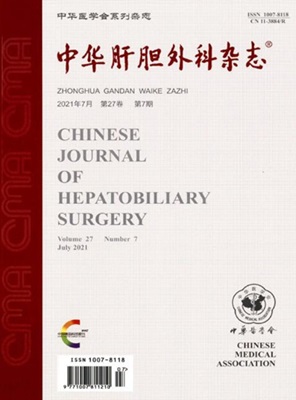Application of indocyanine green fluorescence imaging in open hepatectomy
Q4 Medicine
引用次数: 0
Abstract
Objective To investigate the clinical application of indocyanine green fluorescence imaging in open hepatectomy. Methods A total of forty-five patients who underwent liver resection in Department of Hepatobiliary Surgery, Affiliated Hospital of Southwest Medical University from July 2017 to December 2018 were included in this prospective study. There were 26 males and 19 females, aged between 29 to 74 (51±10) years. Indocyanine green was injected intravenously 72~96 hours prior to surgery in all these patients. An intraoperative fluorescence imaging system was used to locate and remove the tumor, the liver parenchymal transection planes and surgical margins were detected by fluorescence again after tumor resection. The fluorescence profiles of the tumor specimens in relation to the tumor differentiation were analyzed. Results Indocyanine green fluorescence imaging was performed in 45 patients. A total of 66 lesions were detected by preoperative CT (or MRI), abdominal ultrasound and intraoperative fluorescence imaging. After excision of the primary liver cancer, the surgical margins of the remnant liver stumps and fluorescence in the excised liver specimens were studied. Thirteen small lesions were found in 10 patients, most of which were located at the surgical margin, and the smallest tumors detected were less than 5 mm in diameter. Five venous cancer emboli were found in 5 patients, 3 of which were not detected by preoperative imaging examinations. The fluorescence profile images of the excised hepatocellular carcinoma specimens showed homogeneous fluorescence in most highly differentiated hepatocellular carcinoma, and partial fluorescence or ring fluorescence in moderately differentiated hepatocellular carcinoma. Conclusion Indocyanine green fluorescence imaging technology can identify liver surface lesions, as well as detect small residual lesions at the cutting edge and venous thrombus, which improves the efficiency of hepatocellular carcinoma resection. Key words: Hepatectomy; Margins of excision; Indocyanine green; Fluorescence imaging吲哚青绿荧光成像在开放性肝切除术中的应用
目的探讨吲哚青绿荧光显像在肝切除术中的临床应用。方法将2017年7月至2018年12月在西南医科大学附属医院肝胆外科接受肝切除术的45例患者纳入本前瞻性研究。共有26名男性和19名女性,年龄在29至74(51±10)岁之间。所有患者术前72~96小时静脉注射吲哚菁绿。术中使用荧光成像系统定位和切除肿瘤,肿瘤切除后再次通过荧光检测肝实质横断平面和手术边缘。分析了肿瘤标本的荧光图谱与肿瘤分化的关系。结果对45例患者进行吲哚青绿荧光成像。术前CT(或MRI)、腹部超声和术中荧光成像共检测到66个病变。原发性肝癌癌症切除后,对残肝残端的手术切缘和切除肝标本中的荧光进行了研究。在10名患者中发现了13个小病变,其中大多数位于手术边缘,检测到的最小肿瘤直径小于5毫米。5例患者发现5个癌症静脉栓塞,其中3例术前影像学检查未发现。切除的肝细胞癌标本的荧光图谱图像在大多数高分化肝细胞癌中显示均匀荧光,在中分化肝细胞瘤中显示部分荧光或环状荧光。结论吲哚菁绿色荧光成像技术能够识别肝表面病变,并能检测出切缘微小残留病变和静脉血栓,提高了肝细胞癌切除的效率。关键词:肝切除术;切除边缘;吲哚菁绿;荧光成像
本文章由计算机程序翻译,如有差异,请以英文原文为准。
求助全文
约1分钟内获得全文
求助全文
来源期刊

中华肝胆外科杂志
Medicine-Gastroenterology
CiteScore
0.20
自引率
0.00%
发文量
7101
期刊介绍:
Chinese Journal of Hepatobiliary Surgery is an academic journal organized by the Chinese Medical Association and supervised by the China Association for Science and Technology, founded in 1995. The journal has the following columns: review, hot spotlight, academic thinking, thesis, experimental research, short thesis, case report, synthesis, etc. The journal has been recognized by Beida Journal (Chinese Journal of Humanities and Social Sciences).
Chinese Journal of Hepatobiliary Surgery has been included in famous databases such as Peking University Journal (Chinese Journal of Humanities and Social Sciences), CSCD Source Journals of China Science Citation Database (with Extended Version) and so on, and it is one of the national key academic journals under the supervision of China Association for Science and Technology.
 求助内容:
求助内容: 应助结果提醒方式:
应助结果提醒方式:


